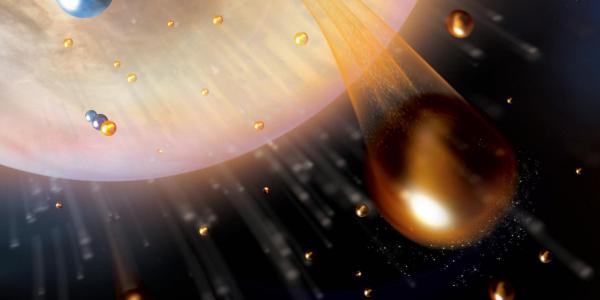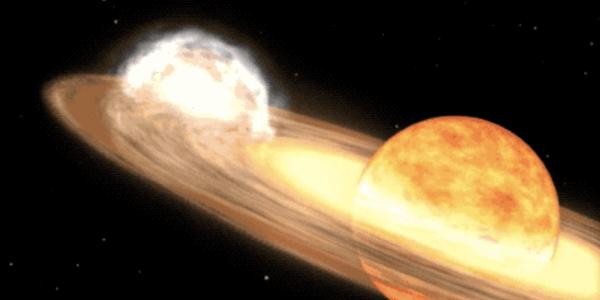A flare erupts from the sun. (Credit:��NASA/SDO)
��
For a new study, a team of physicists recruited roughly 1,000 undergraduate students at CU ɫ������ to help answer one of the most enduring questions about the sun: How does the star’s outermost atmosphere, or “corona,” get so hot?
The research represents a nearly-unprecedented feat of data analysis: From 2020 to 2022, the small army of mostly first- and second-year students examined the physics of more than 600 real solar flares—gigantic eruptions of energy from the sun’s roiling corona.��

Radiation streaming from the sun's corona becomes visible during an eclipse
The researchers, including 995 undergraduate and graduate students, . The results suggest that solar flares may not be responsible for superheating the sun’s corona, as a popular theory in astrophysics suggests.��
“We really wanted to emphasize to these students that they were doing actual scientific research,” said James Mason, lead author of the study and an astrophysicist at the .
Study co-author Heather Lewandowski agreed, noting that the study wouldn’t be possible without the undergrads who contributed an estimated 56,000 hours of work to the project.
“It was a massive effort from everyone involved,” said Lewandowski, professor of physics and , a joint research institute between CU ɫ������ and the (NIST).
Campfire physics
The study zeroes in on a mystery that has left even senior astrophysicists scratching their heads.��
Telescope observations suggest that the sun’s corona sizzles at temperatures of millions of degrees Fahrenheit. The surface of the sun, in contrast, is much cooler, registering only in the thousands of degrees.
“That’s like standing right in front of a campfire, and as you back away, it gets a lot hotter,” Mason said. “It makes no sense.”
Some scientists suspect that especially tiny flares, or “nanoflares,” which are too small for even the most advanced telescopes to spot, may be responsible. If such events exist, they may pop up across the sun on a nearly constant basis. And, the theory goes, they could add up to make the corona toasty. Think of boiling a pot of water using thousands of individual matches.��
The students’ results cast doubt on this theory, Mason said, although he thinks it’s too early to say for sure.
“I was hoping our result was going to be different. I still feel like nanoflares are an important driver of coronal heating,” Mason said. “But the evidence from our paper suggests the opposite. I’m a scientist. I have to go where the evidence is pointing.”

Heather Lewandowski

James Mason
Peak pandemic times
The effort began at the height of the COVID-19 pandemic.
In spring 2020, CU ɫ������, like most universities around the country, had moved its courses entirely online. Lewandowski, however, faced a predicament: She was teaching a class on hands-on research called “Experimental Physics I” that fall, and she had nothing for her students to do.
“This was peak pandemic times,” Lewandowski said. “It's sometimes hard to remember back to what life was like then. These students were very isolated. They were really stressed.”
Mason, who was then a researcher at the (LASP) at CU ɫ������, offered an idea.
The scientist had long wanted to dig into the mathematics of solar flares. In particular, he had tried examining a dataset of thousands of flares that occurred between 2011 and 2018 and had been spotted by instruments in space. They included the National Oceanic and Atmospheric Administration’s (GOES) series and NASA’s (MinXSS), a CubeSat mission designed and built at LASP.
The problem: There were just too many flares to examine on his own.
That’s when Mason and Lewandowski turned to the students for help.��
Mason explained that you can infer details about the behavior of nanoflares by studying the physics of larger flares, which scientists have observed directly for decades.
To do just that, students split into groups of three or four and picked a normal flare they wanted to analyze over the course of the semester. Then, through a series of lengthy calculations, they added up how much heat could each of these events pour into the sun’s corona.
Their calculations painted a clear picture: The sum of the sun’s nanoflares likely wouldn’t be powerful enough to heat up its corona to millions of degrees Fahrenheit.
Educational experiences
What is making the corona so hot isn’t clear. A competing theory suggests that waves in the sun’s magnetic field carry energy from inside the sun to its atmosphere.
But the study’s actual findings aren’t its only important results. Lewandowski said her students were able to have opportunities that are rare for scientists and engineers so early in their careers—to learn first-hand about the collaborative and often-messy way that scientific research works in the real world.��
“We still hear students talking about this course in the halls,” she said. “Our students were able to build a community and support each other at a time that was really tough.”
CU ɫ������ co-authors of the new study include Alexandra Werth, postdoctoral researcher at JILA; Colin West, teaching associate professor in physics; Allison Youngblood, astrophysicist at LASP now at the NASA Goddard Space Flight Center; Donald Woodraska, data systems team lead at LASP; and Courtney Peck, data systems software engineer at LASP and the (CIRES).
Funding for the research came from NASA through the MinXSS mission and the U.S. National Science Foundation through the and .


